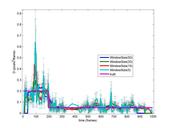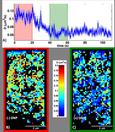Highlight
Single Particle Tracking on Live Cells
Achievement/Results
Patrick Cutler, an INCBN IGERT Trainee, is working on two projects involving single particle tracking on live cells: development of a maximum likelihood estimator for diffusion coefficients, and continued development of single-particle tracking (SPT) in hyperspectral imaging. Typically, the mobility of single particle trajectories is quantified by using a diffusion coefficient. The usage of the diffusion coefficient to quantify mobility of single particles/proteins on the cell surface is based on the assumption of Brownian motion. The most common method used to estimate diffusion coefficients is the mean squared displacement (msd). Limitations of the msd include the use of correlated information in trajectory sampling, incomplete usage of all data points in single particle trajectories due to particle blinking or other phenomena, and variability in single-molecule localization errors.
In order to quantify the mobility of single-molecule trajectories using the underlying model of Brownian motion and to overcome some of the shortcomings of the msd, Patrick Cutler has developed a maximum likelihood estimator for the diffusion coefficient under the guidance of his co-advisor, Prof. Keith Lidke from the Dept. of Physics. This method is currently being used to quantify mobility for a number of different experimental applications, including estimating instantaneous diffusion coefficients for single trajectories and viscosity mapping from high-density SPT. Patrick Cutler is currently preparing a manuscript describing this method.
SPT of labeled proteins on the surface of cells has developed immensely in the last 20 years. Due to technological constraints, SPT experiments have been limited to simultaneous tracking at only two colors. While two-color SPT is sufficient for observations of dimerization, higher-order protein interactions would require multi-color SPT. One example is the aggregation of Fc[epsilon]RI on the cell surface in response to multi-valent antigen. Fc[epsilon]RI , the high affinity IgE receptor, is the primary receptor on mast cells. Crosslinking of IgE-bound Fc[epsilon]RI by antigen initiates intracellular signaling, eventually resulting in the release of histamines and other cellular mediators of the allergic response. In order to better understand the interactions with Fc[epsilon]RI that drive signaling, Patrick Cutler has been developing a high-speed line-scanning hyperspectral microscope for multi-color SPT. This microscope can be used to acquire hyperspectral images (128 spectral bins from 500-750 nm) of a 20-30 sq um region of interest at a rate of ~30 frames per second. This microscope provides the prospect of performing simultaneous SPT of up to 8 colors of quantum dots (QDs). Software for the automated localization and tracking of single QDs in hyperspectral images first needed to be developed.
Patrick Cutler is using a finite pixelated 3-dimensional Gaussian to simultaneously fit spatial and spectral features of individual QDs. This is feasible due to the discrete spectral features of QDs, which can be estimated by using a Gaussian. Spatial and spectral information from localized particles is then used to build trajectories for individual particles. Patrick Cutler is currently working on a manuscript describing the instrument and its application to SPT on live cells. Patrick Cutler is currently working on applying this SPT algorithm to localizing and tracking QD-IgE on live cells, working in the laboratory of his main advisor, Prof. Diane Lidke from the Dept. of Pathology, UNM School of Medicine. SPT of QD-IgE on live cells combined with the quantification of receptor mobility using the maximum likelihood estimator for diffusion will provide significant insights into membrane protein dynamics.
Address Goals
Primary: The projects discussed above provide fundamental tools for investigating biological phenomena. Single-particle tracking in hyperspectral images and methods for interpreting single particle tracking data provide a new platform for investigating dynamic protein interactions that will offer insights into biological questions.
Secondary: The tools are currently being applied to the investigation of membrane protein dynamics. One particular application is investigating signal initiation events for allergies. Insights provided by these studies will foster advancements in our fundamental understanding of the basis for allergies.








